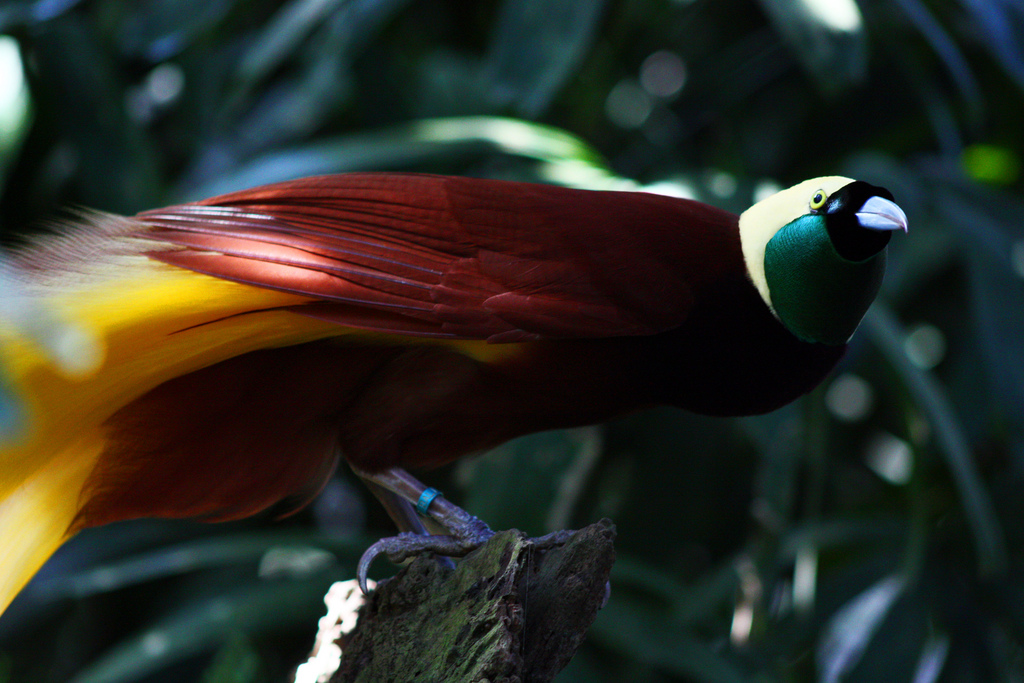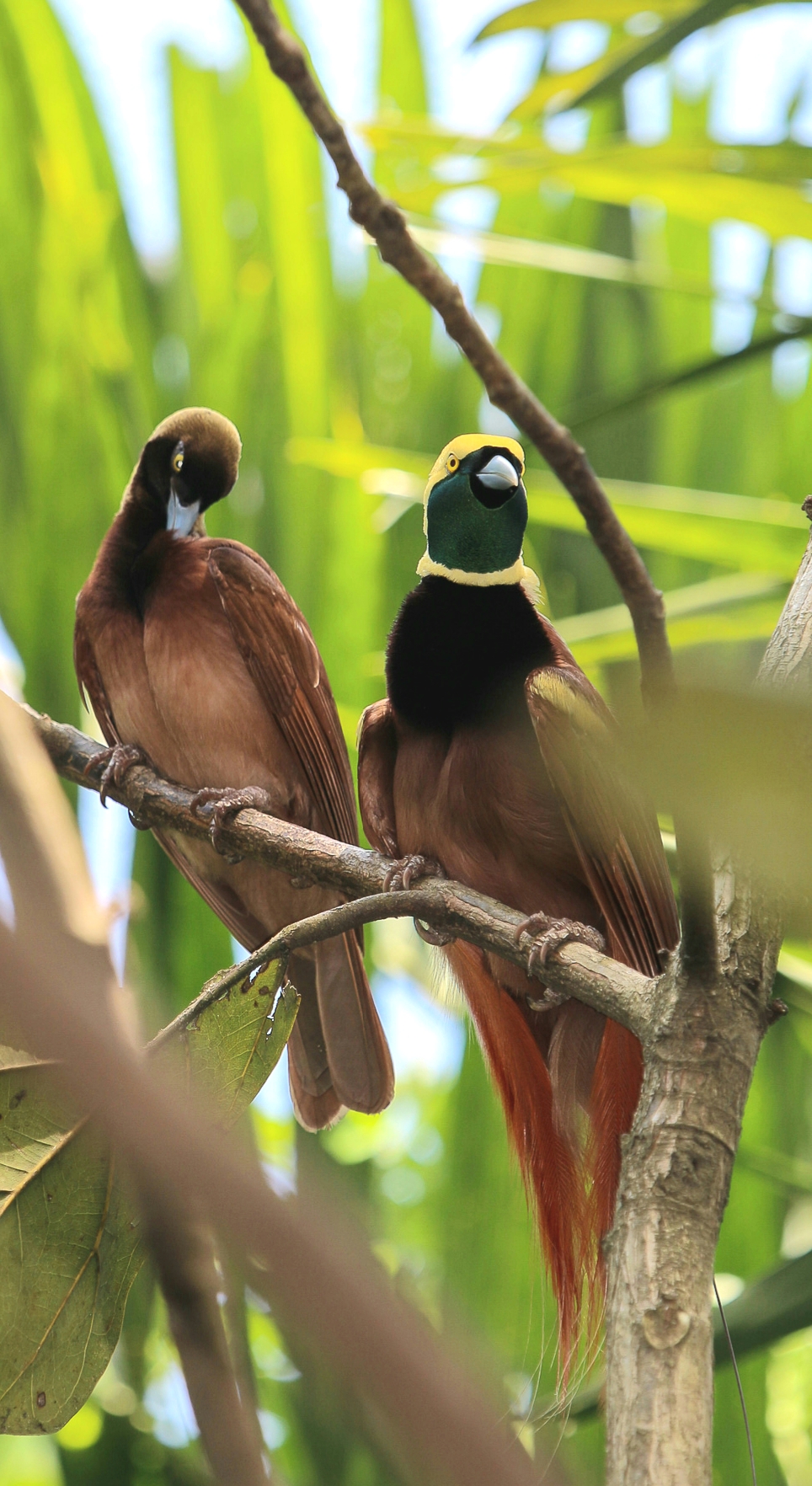|
Paradisaea
The genus ''Paradisaea'' consists of six species of birds-of-paradise (family Paradisaeidae). The genus is found on the island of New Guinea as well as the nearby islands groups of the Aru Islands, D'Entrecasteaux Islands and Raja Ampat Islands. The species inhabit a range of forest types from sea level to mid-montane forests. Several species have highly restricted distributions, and all species have disjunct distributions. A 2009 study examining the mitochondrial DNA of the family found that the ''Paradisaea'' birds-of-paradise were in a clade with the genus '' Cicinnurus''. It showed that the blue bird-of-paradise was a sister taxon to all the other species in this genus. All are large, and sexually dimorphic. The plumage of the males includes characteristic grossly elongated flank plumes (which emerge from beneath the wings and strictly speaking are flank plumes pectoral plumes), and a pair of wire-like feathers emerging from the end of the tail. The flank plumes are used du ... [...More Info...] [...Related Items...] OR: [Wikipedia] [Google] [Baidu] |
Raggiana Bird-of-paradise
The Raggiana bird-of-paradise (''Paradisaea raggiana''), also known as Count Raggi's bird-of-paradise, is a large bird in the bird-of-paradise family (biology), family Paradisaeidae. It is distributed widely in southern and northeastern New Guinea, where its name is ''kumul''. It is also known as ''cenderawasih''. As requested by Count Luigi D'Albertis, Luigi Maria D'Albertis, the epithet ''raggiana'' commemorates the Marquis Francesco Raggi of Genoa. The Raggiana bird-of-paradise is the List of national birds, national bird of Papua New Guinea. In 1971, this species, as ''Gerrus paradisaea'', was made the national emblem and was included on the Flag of Papua New Guinea, national flag. "Papua New Guinea national rugby league team, The Kumuls" ("birds-of-paradise" in Tok Pisin) is also the nickname of the country's national rugby league team. Description The Raggiana bird-of-paradise is long. Its overall colour is a maroon-brown, with a greyish-blue Beak, bill, yellow Iris (an ... [...More Info...] [...Related Items...] OR: [Wikipedia] [Google] [Baidu] |
New Guinea
New Guinea (; Hiri Motu: ''Niu Gini''; , fossilized , also known as Papua or historically ) is the List of islands by area, world's second-largest island, with an area of . Located in Melanesia in the southwestern Pacific Ocean, the island is separated from Mainland Australia, Australia by the wide Torres Strait, though both landmasses lie on the same continental shelf, and were united during episodes of low sea level in the Pleistocene glaciations as the combined landmass of Sahul. Numerous smaller islands are located to the west and east. The island's name was given by Spanish explorer Yñigo Ortiz de Retez during his maritime expedition of 1545 due to the perceived resemblance of the indigenous peoples of the island to those in the Guinea (region), African region of Guinea. The eastern half of the island is the major land mass of the nation of Papua New Guinea. The western half, known as Western New Guinea, forms a part of Indonesia and is organized as the provinces of Pap ... [...More Info...] [...Related Items...] OR: [Wikipedia] [Google] [Baidu] |
Paradisea
''Paradisea'' (paradise lily) is a European genus of flowering plants in the family Asparagaceae. It was formerly classified in the family Anthericaceae or earlier in the Liliaceae. ''Paradisea'' is sometimes confused with ''Anthericum''. Species ''Paradisea'' contains two species of herbaceous perennials: See also * List of plants known as lily Lily usually refers to herbaceous plants of the genus ''Lilium'', with large showy trumpet-shaped flowers. Many species are cultivated as ornamentals. Many other plants not closely related to lilies are called lilies, usually because their flowers ... References Asparagaceae genera Agavoideae {{Asparagaceae-stub ... [...More Info...] [...Related Items...] OR: [Wikipedia] [Google] [Baidu] |
Goldie's Bird-of-paradise
Goldie's bird-of-paradise (''Paradisaea decora'') is a species of bird-of-paradise. Endemic to Papua New Guinea, the Goldie's bird-of-paradise is distributed in the hill forests of Fergusson and Normanby Island of the D'Entrecasteaux Archipelago, eastern Papuan Islands. The diet consists mainly of fruits. The name commemorates the Scottish collector Andrew Goldie, who discovered the bird in 1882. Due to ongoing habitat loss, limited range and overhunting in some areas, the Goldie's bird-of-paradise is evaluated as Vulnerable on the IUCN Red List The International Union for Conservation of Nature (IUCN) Red List of Threatened Species, also known as the IUCN Red List or Red Data Book, founded in 1964, is an inventory of the global conservation status and extinction risk of biological ... of Threatened Species. It is listed on Appendix II of CITES. Description Goldie's bird-of-paradise is large, approximately 33 cm long, and olive-brown. The male has a yellow and ... [...More Info...] [...Related Items...] OR: [Wikipedia] [Google] [Baidu] |
Naturalis Biodiversity Center - RMNH
Naturalis Biodiversity Center () is a national museum of natural history and a research center on biodiversity in Leiden, Netherlands. It was named the European Museum of the Year 2021. Although its current name and organization are relatively recent, the history of Naturalis can be traced back to the early 1800s. Its collection includes approximately 42 million specimens, making it one of the largest natural history collections in the world. History The beginnings of Naturalis go back to the creation of the Rijksmuseum van Natuurlijke Historie (abbreviated RMNH, National Museum of Natural History) by royal decree on August 9, 1820. In 1878, the geological and mineralogical collections of the museum were split off into a separate museum, remaining distinct until the merger of the Rijksmuseum van Natuurlijke Historie with the Rijksmuseum van Geologie en Mineralogie (abbreviated RGM) in 1984, to form the Nationaal Natuurhistorisch Museum (NNM) or National Museum of Natural ... [...More Info...] [...Related Items...] OR: [Wikipedia] [Google] [Baidu] |
Huon Peninsula
Huon Peninsula is a large rugged peninsula on the island of New Guinea in Morobe Province, eastern Papua New Guinea. It is named after French explorer Jean-Michel Huon de Kermadec. The peninsula is dominated by the steep Saruwaged and Finisterre and Cromwell Mountains. The nearest large town is the Morobe provincial capital Lae to the south, while settlements on the north coast include the former German town of Finschhafen, the district capital of Wasu, Malalamai and Saidor with its World War II era Saidor Airport. The Huon Peninsula is home to a diverse range of indigenous communities, each with their own unique cultures and traditions. The region is known for its rich biodiversity, with a wide range of flora and fauna that are found nowhere else in the world. The Huon Peninsula Conservation Area is home to numerous endangered species, including the Huon tree kangaroo and the golden-mantled tree kangaroo. The area was the site of the Huon Peninsula campaign of Wo ... [...More Info...] [...Related Items...] OR: [Wikipedia] [Google] [Baidu] |
Misool
Misool, formerly spelled Mysol (Dutch: Misoöl) or Misol, is one of the four major islands in the Raja Ampat Islands in Southwest Papua, Indonesia. Its area is 2,034 km2. The highest point is 561 m and the main towns are Waigama, located on the island's northwest coast, and Lilinta on the island's southeast coast. The inhabitants speak the Ma'ya language, Biga language and Matbat language, as well as Indonesian language, Indonesian and its dialect, Papuan Malay. Other main islands of this group off the western end of Southwest Papua are Salawati, Batanta and Waigeo, and there are numerous smaller islands such as Kofiau. Etymology The name ''Misool'' is from Ma'ya language which meant port or harbour relating to when the first king from Waigeo Island, Waigeo arrived on the island. Original inhabitants (Matbat language, Matbat) called the island with the name ''Batan Me''. Ecology Terrestrial Misool is part of the Vogelkop–Aru lowland rain forests ecoregion, which includ ... [...More Info...] [...Related Items...] OR: [Wikipedia] [Google] [Baidu] |
Lesser Bird-of-paradise
The lesser bird-of-paradise (''Paradisaea minor'') is a bird-of-paradise in the genus ''Paradisaea''. Description The lesser bird-of-paradise is medium-sized, up to , maroon-brown with a yellow crown and brownish-yellow upper back. The male has a dark emerald-green throat, a pair of long tail-wires and is adorned with ornamental flank plumes which are deep yellow at their base and fade outwards into white. The female is a maroon bird with a dark-brown head and whitish underparts. Further study is required,Venomous Animals of the World, Steve Backshall; 2007, New Holland Publishers (UK), Ltd. but it seems likely that birds-of-paradise also possess toxins in their skins, derived from their insect prey. It resembles the larger greater bird-of-paradise, but the male of that species has a dark chest, whereas the female is entirely brown (no whitish underparts). Breeding The males are polygamous, and perform courtship displays in leks. The female usually lays two pinkish eggs with da ... [...More Info...] [...Related Items...] OR: [Wikipedia] [Google] [Baidu] |
Paradisaea Raggiana 23zz
The genus ''Paradisaea'' consists of six species of birds-of-paradise (family Paradisaeidae). The genus is found on the island of New Guinea as well as the nearby islands groups of the Aru Islands, D'Entrecasteaux Islands and Raja Ampat Islands. The species inhabit a range of forest types from sea level to mid-montane forests. Several species have highly restricted distributions, and all species have disjunct distributions. A 2009 study examining the mitochondrial DNA of the family found that the ''Paradisaea'' birds-of-paradise were in a clade with the genus '' Cicinnurus''. It showed that the blue bird-of-paradise was a sister taxon to all the other species in this genus. All are large, and sexually dimorphic. The plumage of the males includes characteristic grossly elongated flank plumes (which emerge from beneath the wings and strictly speaking are flank plumes pectoral plumes), and a pair of wire-like feathers emerging from the end of the tail. The flank plumes are used duri ... [...More Info...] [...Related Items...] OR: [Wikipedia] [Google] [Baidu] |
Greater Bird-of-paradise
The greater bird-of-paradise (''Paradisaea apoda'') is a bird-of-paradise in the genus '' Paradisaea''. Carl Linnaeus named the species ''Paradisaea apoda'', or "legless bird-of-paradise", because early trade skins to reach Europe were prepared without wings or feet by the indigenous New Guinean people; this led to the misconception that these birds were beautiful visitors from paradise that were kept aloft by their plumes and never touched the earth until death. Taxonomy The greater bird-of-paradise was formally described by the Swedish naturalist Carl Linnaeus in 1758 in the tenth edition of his ''Systema Naturae'' under the current binomial name ''Paradisaea apoda''. The genus name is from the Late Latin ''paradisus'' meaning "paradise", due to the voyagers in Ferdinand Magellan's circumnavigation of the Earth, the first Europeans to encounter this animals. Antonio Pigafetta, the main chronicler of that expedition, wrote that "The people told us that those birds came from t ... [...More Info...] [...Related Items...] OR: [Wikipedia] [Google] [Baidu] |
Paradisaea Apoda -Bali Bird Park-5
The genus ''Paradisaea'' consists of six species of birds-of-paradise (family Paradisaeidae). The genus is found on the island of New Guinea as well as the nearby islands groups of the Aru Islands, D'Entrecasteaux Islands and Raja Ampat Islands. The species inhabit a range of forest types from sea level to mid-montane forests. Several species have highly restricted distributions, and all species have disjunct distributions. A 2009 study examining the mitochondrial DNA of the family found that the ''Paradisaea'' birds-of-paradise were in a clade with the genus '' Cicinnurus''. It showed that the blue bird-of-paradise was a sister taxon to all the other species in this genus. All are large, and sexually dimorphic. The plumage of the males includes characteristic grossly elongated flank plumes (which emerge from beneath the wings and strictly speaking are flank plumes pectoral plumes), and a pair of wire-like feathers emerging from the end of the tail. The flank plumes are used duri ... [...More Info...] [...Related Items...] OR: [Wikipedia] [Google] [Baidu] |








